Basketball Motion Offense Principles
By Dr. James Gels, from the Coach’s Clipboard Basketball PlaybookSee more comments...

More Reading on Motion Offenses
- Spacing and Movement - Moving Without the Ball
- Bob Hurley: Motion Offense
- 3-2 Motion Offense
- 4-Out, 1-In Motion Offense
- Open Post (5-Out) Motion Offense
- Duke Transition and Early Motion Offense Options
- Notes on the Read and React Offense
- Dribble-Drive Motion Offense
- Slice Motion Offense
- Simple Slam Motion Offense
Motion offense is a flexible offense that features player movement, floor spacing, passing and cutting, and screening. The origin of "motion offense" is usually credited to coach Henry Iba at Oklahoma State, and his assistant Bloomer Sullivan (who became a great coach in his own right at Southeastern Oklahoma State University). It was further developed and popularized by coach Bob Knight at Indiana, who used screening as a key part of the offense.
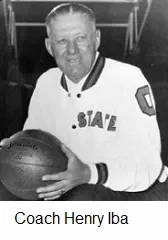
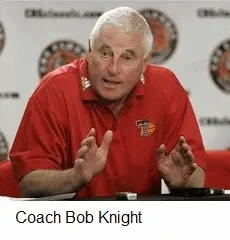
Motion offense can be run with almost any set - 3-out, 4-out, 5-out, etc. Once the basic concepts are learned, special patterns and plays can be designed by the coach to take advantage of his team's offensive strengths.
The 3-out, 2-in set uses three perimeter players and two post players. This set provides good balance between the perimeter game and strong inside post play, with good offensive rebounding presence.
Teams that don't have true post players (and are more guard-oriented) could use either the 4-out, 1-in motion offense or the 5-out open post motion offense.
The now popular "dribble-drive motion offense" uses a 4-out set and very little screening. You can also use a 1-3-1 or a 1-4 set.
For purposes of this discussion, I will use the 3 out, 2 in set (see diagram A). In this set, have the two posts rotate with each other and the three perimeter players rotate in the three outside positions.
Always try to have your point guard O1 bring the ball up the floor and start the offense. Make sure that whoever is at the O1 position when the shot is taken, stays back to prevent the opponent's fast break. The O3, O4, O5 positions go for the offensive rebound and the O2 position plays half-rebound and half-prevent mode.
Basic rules:
Spacing
Players should stay 12 to 15 feet apart. Avoid bunching up, which clogs passing lanes and lanes for dribble-penetration. Poor spacing can result in double-teams, steals, interceptions, and turnovers.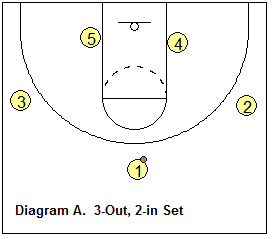
Triple threat position and patience.
Perimeter players should receive the pass in triple threat position, where the player has the options of shooting, driving to the hoop, or passing. In triple threat position, perimeter players should (1) look into the post, (2) read the defense and look for the opportunity for a shot, shot fake, or a dribble-move.Perimeter players should be patient and hold the ball for a count of two to allow screens and cuts to develop. Cutters and screeners need time to execute. The exception is when the defense is coming to trap, then pass immediately.
Teach your players, after receiving a pass on the perimeter, not to immediately start dribbling, or bounce it once, and then lose the dribble. The player loses the options of shooting and driving to the hoop, and passing is more difficult when the defender closes in, and the other defenders go into deny. We are constantly teaching and reminding players to "get in triple threat position".
Players may dribble:
1. To attack the basket with a dribble-drive.2. Improve or open a passing lane.
3. Penetrate gaps in a zone defense.
4. To get out of trouble and avoid the 5-second count.
5. To exchange positions with another player. For example, if you want the ball to go to the wing, and the defense is denying the pass, the point guard can simply dribble to the wing, and the wing player can exchange and go to the point.
6. To run a weave-screen play.
Player Movement
Players must move with a purpose and not stand still.1. Post players can screen for each other and move up and down the lane to the low blocks, elbows, top of the free throw line, and short corners. They can ball-screen (pick and roll), and back-screen (away from the ball).
2. Perimeter players occupy the three positions shown in diagram A, and also move to the corners. They may make front or backdoor cuts to the hoop, and V-cuts to replace themselves (see Cutting and Faking). They can screen-away, down-screen, or ball-screen and run the pick and roll (see Setting and Using Screens). They must move after making a pass.
Perimeter players should maintain good spacing and keep the defense spread out. Fill the open spots on the perimeter. An outside player can make a cut inside, but should not stay there and clog things up for our post players. For example, if O1 cuts inside through the paint and does not receive the pass, he/she should immediately cut out to the opposite corner/wing, while that wing player moves up to fill the spot at the point.
If O1 is having difficulty passing to the wing (the defense is denying the wing pass), he/she can simply dribble the ball to the wing. We have a rule (except in a weave-screen play): whenever a teammate is dribbling toward you, back-cut out of the area. For example, if O1 dribbles toward O2, O2 back-cuts underneath along the baseline and fills the O3 spot while O3 rotates to the point. Another thing you can do when the wing pass is being denied is run a "weave-screen" play.
Passing
We want to get the ball into the low post. A wing entry is usually the easiest way. You can also get there by passing to the high post at the free throw line, and the high-post then passes to the low post. Passers must "see the defense" and not pass into the defense.Don't pass to someone standing still as these passes are more likely to be intercepted.
After passing, players must do one of these:
1. Cut to the hoop for the return pass ("give and go" play).
2. Screen away. Example: after the point guard passes to the right wing (O2), he sets a screen for the left wing (O3).
3. Follow the pass and set a ball-screen (pick and roll).
4. V-cut and replace self.
5. After a cross-court "skip" pass (example from wing to wing), slide out of the defender's line of vision and cut backdoor to the hoop.
6. After a wing passes to the low post, he/she should slide down to the corner. If the post player is double-teamed, the corner is usually the easiest pass back outside and is often open for the 3-point shot.
Read the defense
Situations for Perimeter players:
1. You have the ball and the defender is playing you up tight: make a jab-step fake and drive straight to the hoop. Make contact with the defender's shoulder and get him/her on your backside. Don't go wide. If help defense closes in, dish to the low post where the help came from. (See Guard Moves and Skills)2. You have the ball and the defender is sagging off you: shoot the outside shot. 3. You have the ball and the defender is playing good defense on you: pass to a teammate and then execute one of the five options above (what to do after passing).
4. You have the ball and the defender is playing good defense on you and your teammates are being denied the pass: call out and execute a weave screen play.
5. You are one pass away and the defender is sagging off you: make a V-cut inside and come back out for the perimeter pass.
6. You are one pass away and the defense is denying the pass to you: Make a fake outside, and then back-cut. The low post on that side should learn to read this situation also and either cut to the high post or clear out to the opposite side, to make spacing for the backdoor cut.
7. You are one pass away, and the defender is playing good defense and you can't get free: Set a screen either for the ball or the low post.
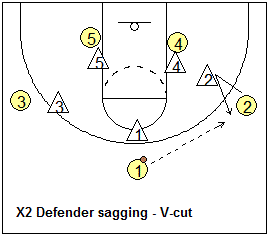


Situations for post players:
1. Read the defensive over-play (deny) on the wing. Flash to the high post to receive the ball and then pass to the wing going backdoor (see Diagram B2).2. You get the ball 1-on-1 against the defense: Make a low post move. Try to score or get fouled. (see How to Become a Good Post Player).
3. You get the ball and are double-teamed: Pass the ball back outside, often to where the double team came from. Going "inside-out" is a good way to get open 3-point shots.
Post players working together: (see the diagrams below)
1. If the ball-side post is being fronted: the opposite post flashes to the ball-side elbow for the pass. Meanwhile the low post player seals the defender on his back, and the post at the elbow passes inside to the low post for the lay-up.
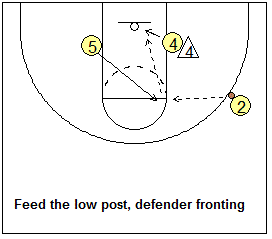

2. If the ball-side post defender is playing behind: The wing passes to the post, and the opposite post player clears out to the weak-side elbow.
3. If the ball-side post defender is 1/2 or 3/4 defending with a hand in front: the ball-side post should set a screen for the weak-side post, who cuts to the ball for the pass and lay-up. If the low post defenders switch this screen, then the low post cutter should move out to the ball-side short corner (or high-post), and the screener should seal his defender and come back to the ball for the lay-up.
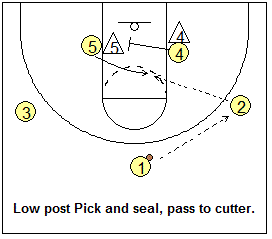
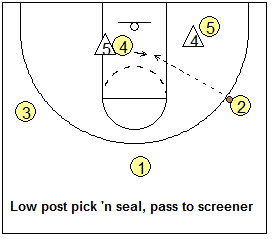
Also see: Hi-Lo options.
Once your players learn these concepts, devise your own patterns and plays to create opportunities for your best scorers and exploit the defense's weaknesses.
If you have a shortage of post players, consider the 4-out, 1-in motion offense, the "dribble-drive motion offense", the 5-out (open-post) motion offense, or the Open-Post Double-Up motion offense.
Related pages:
- Spacing and Movement - Moving Without the Ball
- Bob Hurley:Motion Offense
- 3-2 Motion Offense
- Slam Motion Offense
- Drills for Teaching the 3-2 Motion Offense
- Motion Offense Screening Drills
- Guard (Perimeter) Breakdown Drills
- Post Player Breakdown Drills
- 3-2 Motion Options
- 3-2 Motion Plays
Coach's Clipboard All-Access Premium Membership
Become a Premium Member now and get immediate access to everything at the Coach's Clipboard... mobile-ready with all of the complete articles, video clips, pdf files, expandable animations, a youth basketball section, a free Playbook download... more details. Get access right NOW... no waiting, nothing to ship.
Coach's Clipboard Playbook Download
This is the complete collection of all Coach's Clipboard files in a download. This unique basketball program was designed for youth through high school level coaches, and cannot be found in stores. It includes the Basketball Playbook and Animated Diagrams, all of the video clips, pdf files, and more. Free downloadable upgrades for one year! More information, contents...
Become a Premium Member now and get immediate access to everything at the Coach's Clipboard... mobile-ready with all of the complete articles, video clips, pdf files, expandable animations, a youth basketball section, a free Playbook download... more details. Get access right NOW... no waiting, nothing to ship.
Coach's Clipboard Playbook Download
This is the complete collection of all Coach's Clipboard files in a download. This unique basketball program was designed for youth through high school level coaches, and cannot be found in stores. It includes the Basketball Playbook and Animated Diagrams, all of the video clips, pdf files, and more. Free downloadable upgrades for one year! More information, contents...